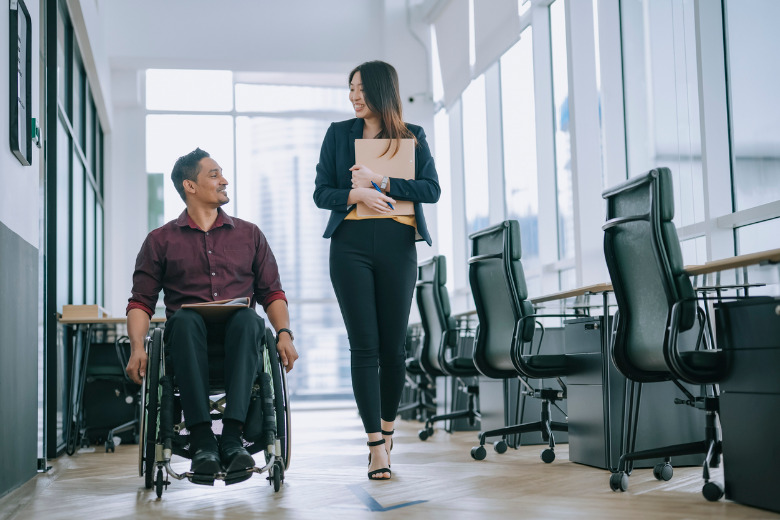
A new strategy from the government will ensure that people with disability can participate as equal members of society.
Australia’s Disability Strategy 2021-2031 will be supported by a $250 million investment from the federal government.
Launched today to mark International Day of People with Disability, the strategy is the result of extensive consultations with people with disability and the disability sector.
Minister for Families and Social Services Anne Ruston said the strategy seeks to ensure that real action will be taken.

“Unless we actually can embed, in every single part of our society, inclusion and access for people with disability, we will have failed and we don’t intend to fail,” she said at the launch.
The strategy focuses on several areas, but Ms Ruston said one is key.
“The one that I have been particularly focused on has been around making sure that people with disability have the same opportunities to employment as every other Australian,” she said.
“Having a job is a game changer in anybody’s life and there should be no reason why that should be any different for somebody who lives with disability.”
“People with disability report the greatest barriers they face are not communication or physical, rather they are created through stigma, unconscious bias and lack of understanding of disability.”
Employ My Ability
As part of the strategy’s focus on jobs, Ms Ruston has launched Employ My Ability, the Disability Employment Strategy, to provide a framework for governments, employers and the wider community to increase employment outcomes for people with disability.
“It recognises that even though we know that employers, when we ask them, are warm to the idea of employing somebody with a disability, it’s not translating into action,” she said.
“So, what we need to do is to make sure that we are giving the tools and the confidence to employers across Australia to actually employ somebody with disability.
“Because those who do find out very, very quickly that people with disability make some of the most extraordinary employees, and the value to their business is exceptional.”
The Disability Employment Advisory Committee was established by the federal government at the beginning of this year to inform the development of the National Disability Employment Strategy and is cochaired by Simon McKeon and Dylan Alcott.

The employment strategy will be a 10-year commitment with four key areas, including lifting employer engagement, building employment skills, improving systems and services for jobseekers and employers and changing community attitudes.
Mr McKeon believes the last point is the most important.
“The mythology that it doesn’t work is still around, and the most important objective is to get rid of that mythology and apprise the nation and employers in particular of what is what is real,” he said at the launch.
“Unless there’s national cultural change, we know that the first three things would only go partway.”
“Having a job is a game changer in anybody’s life and there should be no reason why that should be any different for somebody who lives with disability.” – Minister for Families and Social Services Anne Ruston
More Inclusive and safe communities
Other outcomes of the disability strategy including ensuring that people with disability will live in inclusive and well-designed homes and communities.
“Having appropriate housing, and a community that is accessible and inclusive, is central to how people with disability live, work and socialise,” the strategy said.
“Accessible housing, transport, communication and the built environment are key factors supporting the participation of people with disability.”
It is also important to create communities where people with disability feel safe, according to the strategy.
“People with disability are experts in their own lives and have the same rights as people without disability,” the strategy said.
“Community acceptance of these rights and experiences will maximise individual power and autonomy, and support economic participation, social inclusion, safety and equality.”
Changing community attitudes
Central to achieving an inclusive society is fostering positive community attitudes towards people with disability, the strategy said.
“People with disability report the greatest barriers they face are not communication or physical, rather they are created through stigma, unconscious bias and lack of understanding of disability,” it said.
“People with disability have said changing attitudes of others will provide more choice and independence, and lead to better support, improved treatment and more respect.”
Education and health and wellbeing
The strategy aims to see people with disability achieve their full potential through education and learning.
“Despite educational reforms over the last decade, there remain significant gaps for students with disability,” the strategy said.
Another aim of the strategy is to ensure that people with disability attain the highest possible health and wellbeing outcomes throughout their lives.
It will also ensure they have access to a range of supports to help them live independently and engage in communities.
All levels of government are required to report their progress on the strategy. This includes the Targeted Action Plans Report and Outcome Framework Report and Dashboard, both produced annually.
The Implementation Report will be produced every two years and the two Major Evaluation Reports will be published in 2025 and 2029.
According to the strategy, people with disability will play a central and active role in the implementation of the strategy.
Comment below to have your say on this story.
If you have a news story or tip-off, get in touch at editorial@governmentnews.com.au.
Sign up to the Government News newsletter